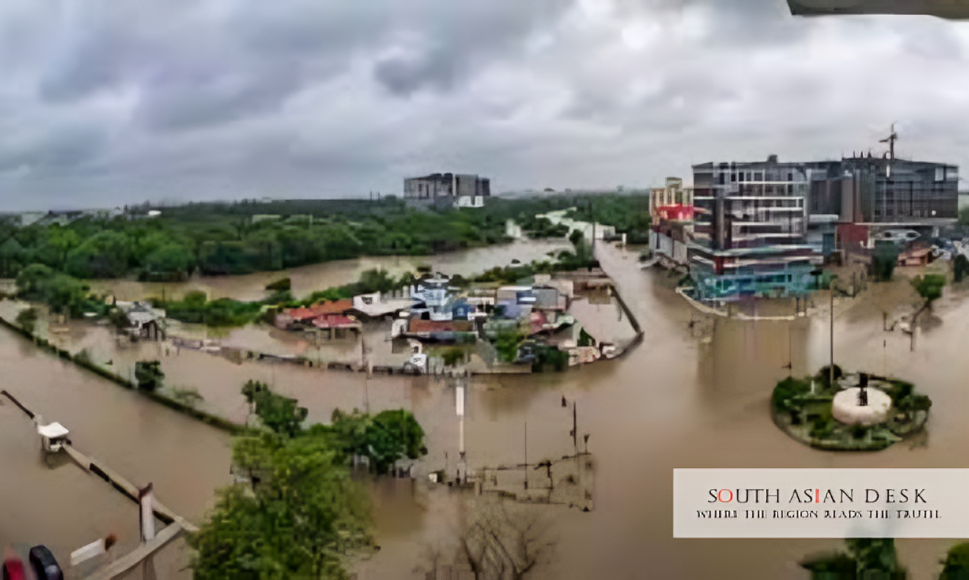As relentless monsoon rains subside, the human and economic toll of floods 2025 in Pakistan, with fresh urban inundations in Punjab raising fears of prolonged recovery challenges.
Lahore, 20 September 2025 – Thefloods 2025 in Pakistan, triggered by heavy monsoon downpours since late June, have claimed at least 1,002 lives nationwide, displaced millions, and inflicted widespread damage across Punjab and Sindh provinces, with urban flash flooding striking Gujrat on Friday, 19 September.
The floods 2025 in Pakistan represent one of the most severe weather-related disasters in South Asia this year, exacerbating food insecurity and straining regional water-sharing dynamics under the Indus Waters Treaty. With agriculture, a backbone of Pakistan’s economy, severely hit, ripple effects could include higher staple prices across neighbouring India and beyond, underscoring the need for cross-border climate resilience strategies.
Escalating Crisis in Punjab
Punjab province has borne the brunt of the floods 2025 in Pakistan, with official data indicating 216 fatalities and over 2 million people affected as of early September. Torrential rains between 25 and 27 August led to exceptionally high flooding in the Sutlej, Chenab, and Ravi rivers, inundating more than 2,000 villages and submerging vast swathes of cropland dedicated to rice, sugarcane, maize, and cotton during harvest season.
The Provincial Disaster Management Authority (PDMA) Punjab reported that authorities evacuated 909,229 individuals and 516,000 heads of livestock to safer locations, establishing over 700 relief camps to shelter around 12,500 displaced persons. An additional 378 medical camps and 330 veterinary facilities have provided treatment to thousands, addressing outbreaks of waterborne diseases amid the chaos.
In South Punjab districts including Multan, Lodhran, and Bahawalpur, a breach in the Sutlej River at Noraja Bhutta on Thursday submerged 150 villages, displacing thousands more. The PDMA noted that 1,174,870 people across 1,112 villages in the region have been impacted, with 1,249,328 acres of crops destroyed. Infrastructure woes persist, with the M5 Motorway partially closed due to 10-12 km of flooding and a 22-km section under repair.
Punjab Chief Minister Maryam Nawaz Sharif announced comprehensive rehabilitation measures, stating that households with completely destroyed homes would receive PKR 1 million, while those with partial damage qualify for PKR 500,000. Large livestock losses would be compensated at PKR 500,000 per animal, and small livestock at PKR 50,000, with distributions slated within two weeks.
Gujrat Floods 2025 in Pakistan: Urban Deluge Adds to Woes
The ongoing floods 2025 in Pakistan took a dramatic turn in Gujrat district on Friday, 19 September, when an intense hour-long downpour caused rapid urban inundation. Low-lying neighbourhoods and major streets in Gujrat city accumulated several feet of water, paralysing traffic and halting operations at key government offices, including the Deputy Commissioner’s premises.
Residents faced severe disruptions, with reports of a motorcyclist falling into an open manhole before being rescued by passersby. Power outages compounded the misery, as multiple feeders tripped in nearby areas like Sangla Hill, leaving households without electricity. The incident highlights vulnerabilities in Punjab’s urban centres, where inadequate drainage systems amplify the risks posed by the retreating monsoon.
PDMA Punjab had issued a moderate flood alert for urban flooding risks in the Gujrat division earlier in the season, warning of potential overflows in nullahs linked to the Ravi River. This recent Gujrat Pakistan flooding episode affected not only local commerce but also commuters on key routes, with similar disruptions reported in Lahore and Faisalabad from concurrent heavy rains and hailstorms.
Broader Impacts Across Sindh and Beyond
While Punjab grapples with riverine and urban floods, Sindh province has seen medium flood levels persist at key Indus River barrages. As of Saturday morning, outflows at Sukkur exceeded 360,000 cusecs, with Kotri nearing 320,000 cusecs, both holding steady. The Sindh PDMA reported 180,000 people affected, with 760 individuals housed in 528 relief camps and 117,226 patients treated in 144 medical facilities.
Nationwide, the National Disaster Management Authority (NDMA) and UN Office for the Coordination of Humanitarian Affairs (OCHA) data reveal 1,176 injuries alongside the fatalities. Over 8,400 houses, 239 bridges, and nearly 700 km of roads have been damaged, with livestock losses mounting – 1,473,309 animals treated in Sindh alone.
The Pakistan Meteorological Department (PMD) confirmed the monsoon retreat on Friday, forecasting hot and dry conditions for the coming week, which may aid drying efforts but prolong agricultural recovery. Earlier warnings from NDMA about excessive monsoon activity, issued in mid-August, had anticipated such deluges, yet the scale has overwhelmed response capacities.
Background
The floods 2025 in Pakistan echo the devastating 2022 inundations but stem from a westerly wave approaching upper regions from 15 September, persisting until 19 September. Intense rainfall since 26 June has triggered flash floods primarily in Balochistan, Khyber Pakhtunkhwa, Punjab, and Sindh, with Gilgit-Baltistan and Pakistan-administered Kashmir also reporting casualties. OCHA notes that women and children comprise nearly half of the victims, underscoring gender-disparate vulnerabilities in flood-prone areas.
International aid has begun flowing, with the United States approving funding on 9 September for relief operations – the first such assistance post-disaster. However, local inquiries, including a provincial probe ordered by the Punjab Chief Minister, have led to the suspension of four officials amid allegations of preparedness lapses.
What’s Next
As water levels in major rivers like the Indus recede to low flood stages, focus shifts to reconstruction amid the floods 2025 in Pakistan. Authorities anticipate distributing compensation within weeks, but sustained international support will be crucial to rebuild resilient infrastructure and safeguard against future Gujrat Pakistan flooding episodes.
Published in SouthAsianDesk, September 20th, 2025
Follow SouthAsianDesk on X, Instagram, and Facebook for insights on business and current affairs from across South Asia.






